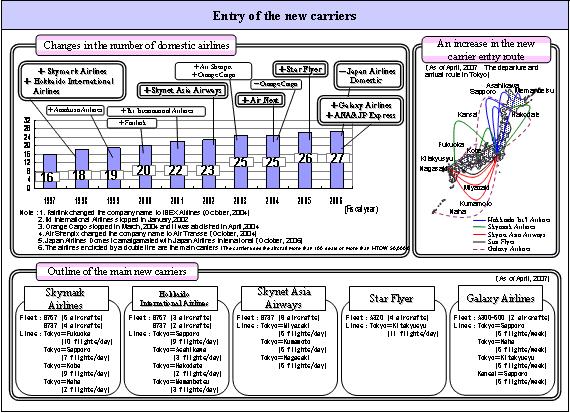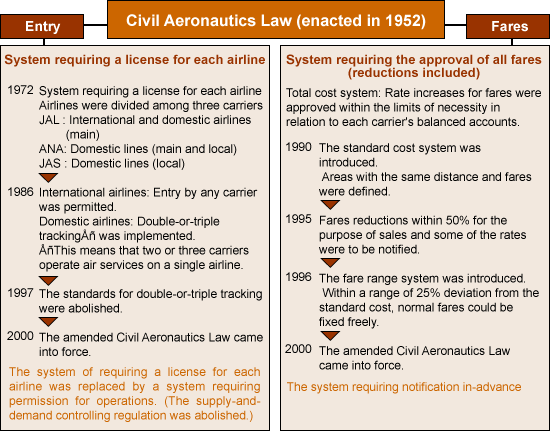 |
|
 |
 |
 |
Domestic aviation network
In Japan there are currently 314 airlines and a network connecting the regions has been developed with Haneda Airport as the center. In addition, there are special reduced fares including the Visit Japan Fare, which allows foreign visitors to travel around Japan more easily and economically. |
 |
Outline of the major carriers in Japan
The aviation industry of Japan has been based on the major three carriers, Japan Airlines (JAL), All Nippon Airways (ANA), and Japan Air System (JAS), and their company groupings. However, due to the integration of JAL and JAS in October 2002, an industry mainly consisting of two major groups has been established. Besides these major company groups, Skymark Airlines (SKY) and Hokkaido International Airlines (ADO) launched into domestic air transport in 1998, and Skynet Asia Airways (SNA) participated in 2002, moreover, Star Flyer (SFJ) and Galaxy Airlines (GXY) participated in 2006. |
 |
 |
 |
 |
Deregulation of domestic air transport
In domestic air transport, deregulation has advanced gradually according to the growth of the air transport industry and the market. In February 2000, in order to improve user convenience through competition between the carriers, the regulations on air transport were radically revised. In this revision, the conventional system requiring a license for each airline was replaced by a system requiring permission for operations. Thus entry into the business of air transport services has become easier. In addition, concerning the fare rates and changes to the fare structure, the conventional approval system was replaced by a system of notification in-advance. The latter system allows carriers to freely set and change fares, while it is also oriented to protect users by making it possible to order carriers to change unfair charges. |
 |
 |
 |
 |
More varied and less expensive domestic air transport fares
Since deregulation allowed domestic air transport fares to be set freely, the type of fares has become more diverse. Thus improvements in convenience for users have been promoted.
In addition to the conventional normal fares, coupon ticket reductions and group reductions, there are sale-type fares by area, whose boarding period and selling period are limited. Among specific fares, besides the conventional reductions for the disabled, there are reductions for returning home to nurse care. Moreover, reflecting the age of information and telecommunications, the number of reasonable fares and rates for both carriers and users is increasing, such as reductions for Internet sales. Due to these advantageous fares for users, the number of domestic passengers is tending to increase.
|
|












